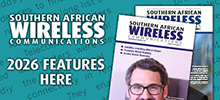07 October 2024

By Ramesh Ramaswamy, EVP & GM, International Division, Hughes
In recent years, internet connectivity in Africa has experienced remarkable growth. At the end of 2023, 37% of the African population had access to the internet, a significant increase from just 26% in 2019. This growth represents a substantial step towards digital inclusion for millions across the continent. However, challenges remain in closing the connectivity gap, particularly in rural and underserved regions. Satellite operators like Hughes are positioned to be major enablers for telecom providers throughout Africa – assisting these providers in expanding their reach, addressing operational pain points, and evolving to meet the market’s needs.
Expanding Reach into New Markets
Satellite companies are key partners for telecom providers looking to extend business operations into new geographies and markets. One of the most effective ways we do this is through backhaul services for mobile networks. Many telecom operators utilize very-small-aperture terminals (VSATs) to provide backhaul in areas where fiber optic networks are absent. This capability allows mobile operators to extend their coverage to underserved regions, enabling them to offer 3G, 4G, and even 5G services where terrestrial infrastructure does not currently exist. Hughes supports over 5,550 VSAT sites throughout Africa, working with major telecom players such as Algerie Telecom, Ethio Telecom, Telcom Malagasy (Telma Madagascar), Telkom SA, and Vodacom Group in South Africa and the Democratic Republic of Congo.
In addition to extending mobile network coverage, satellite technology plays a vital role in bridging the connectivity gap in remote areas. Countries including Ethiopia, Botswana, Nigeria, Kenya, and South Africa utilize VSATs to deliver internet services to remote schools, health clinics, and businesses where laying fiber cables is prohibitively expensive and time-consuming. Through partnerships with Yahclick and Eutelsat Konnect, Hughes delivers affordable internet solutions to consumers and small and medium-sized enterprises (SMEs) – playing a crucial role in addressing the connectivity challenges these regions face. In Egypt, Hughes is also helping broadcast players like Nilesat diversify its business to offer internet connectivity by providing a robust ground system for the Nilesat 301 satellite.
Beyond consumer applications, satellite technology is used to support business operations for enterprises, particularly in sectors such as financial services, mining, agriculture, and government. Telecom operators partner with businesses needing reliable internet connectivity in remote locations, fostering economic growth and promoting digital inclusion. In Ethiopia, Algeria, Egypt, and South Africa, the oil and gas and mining sectors rely on VSATs for communications at isolated sites, ensuring they remain connected and operational.
Addressing Pain Points and Reducing Costs
Telecom providers face many challenges in extending connectivity to new areas of Africa. Thankfully, they aren’t alone in facing these challenges and through partnerships with satellite companies, telecom providers in Africa are addressing significant pain points and reducing operational costs across the board. Many areas on the continent present formidable challenges for traditional telecom infrastructure such as fiber optics or cell towers. Rugged terrain and poor road access often make reaching these areas impractical. VSAT systems circumvent these obstacles by providing direct satellite connectivity, allowing telecoms to serve remote locations without the burden of expensive infrastructure. The high cost of laying fiber optic cables presents another barrier to connectivity. Installing fiber networks in remote or sparsely populated regions is economically unfeasible. VSATs offer a cost-effective alternative, helping telecom operators to provide services without the heavy capital investment required for fiber installations.
In rural areas with unstable or nonexistent power grids, installing telecom equipment is challenging. VSAT systems, which can operate on solar or other renewable energy sources, provide an ideal solution for delivering connectivity in off-grid locations. Conversely, urban networks often face congestion and limited capacity, leading to slow speeds and frequent outages. VSATs alleviate this congestion by offering additional bandwidth and enhancing network performance, particularly during peak usage times. Unlike traditional networks, which can take years to implement, VSAT systems are deployed rapidly—sometimes within days—allowing telecoms to provide services swiftly, whether for rural expansion or emergency connectivity.
Evolving to Meet Market Needs
As the telecom landscape evolves, satellite companies are integral to helping providers meet the evolving needs of the market. The expansion of 5G networks is one area where satellite technology plays a pivotal role. With 5G, users can expect faster data speeds and the ability to connect more devices, facilitating innovations including smart hospitals. Low-Earth Orbit (LEO) satellites are crucial in extending 5G coverage to remote and underserved areas where traditional infrastructure may not reach.
Beyond extending 5G networks, scaling IoT connectivity also presents a great opportunity for telecom and satellite operators. IBM predicts that the number of connected devices worldwide is expected to double by 2030. For industries such as agriculture, mining and environmental monitoring, many of these devices will be in or pass through places where terrestrial connectivity is not available. Satellites enable IoT and machineto-machine (M2M) communications where terrestrial networks do not exist, driving new opportunities for innovation within the telecom sector.
Conclusion
Satellite technology is a critical component of the connectivity landscape in Africa. By collaborating with telecom providers, satellite companies can expand their reach into new markets, address existing pain points, and evolve to meet the diverse needs of the market. The future of connectivity in Africa relies on the successful integration of satellite solutions, ensuring that all individuals and communities have access to the internet and the economic growth opportunities it brings. Together, satellite and telecom providers are poised to make significant strides in closing the connectivity gap and fostering a more inclusive digital economy across the continent.
Mr. Ramaswamy leads the International Division at Hughes, which provides satellite broadband equipment and services for network operators, enterprises and consumers outside the United States both directly and through subsidiaries.







